


Go to chapter: 1 | 2 | 3 | 4 | 5 | 6 | 7 | 8 | 9 | 10 | 11 | 12 | 13 | 14 | 15 | 16 | 17 | 18 | 19 | 20 | 21 | 22 | 23 | 24 | 25 | 26 | 27 | 28 | 29 | 30 | 31 | 32 | 33 | 34 | 35 | 36 | 37 | 38 | 39
Chapter 32 (page 158)




Go to chapter: 1 | 2 | 3 | 4 | 5 | 6 | 7 | 8 | 9 | 10 | 11 | 12 | 13 | 14 | 15 | 16 | 17 | 18 | 19 | 20 | 21 | 22 | 23 | 24 | 25 | 26 | 27 | 28 | 29 | 30 | 31 | 32 | 33 | 34 | 35 | 36 | 37 | 38 | 39
Chapter 32 (page 158)
A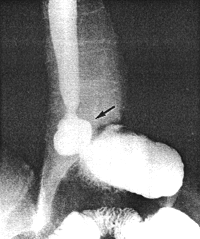 | 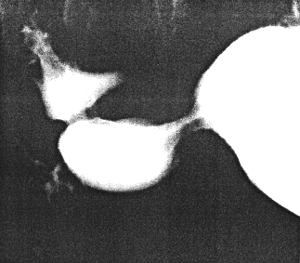 B B |
| Fig. 32.4 A. Case C.W. Sliding hiatus hernia with free gastro-oesophageal reflux (arrow). B. Case C.W. Constant contraction of pyloric sphincteric cylinder. Pyloric aperture "fixed" in open position | |
Case 32.5. N.M., female aged 64 years. Radiographic examination showed a sliding hiatus hernia (Fig. 32.5A), with free and persistent gastro-oesophageal reflux at times. There was a constantly contracted pyloric segment, 4.0 cm in length, corresponding to contraction of the pyloric sphincteric cylinder (Fig. 32.5B). At operation the hernia was repaired via an abdominal route. Palpation of the exposed stomach was equivocal, the surgeon being uncertain whether the pyloric musculature was spastic or thickened, or not. The stomach was not opened. Symptoms suggestive of partial small bowel obstruction appeared a few weeks after the operation. At a second operation 4 months after the first, small bowel adhesions, which had caused the partial obstruction, were severed. At this operation a vagotomy and pyloroplasty were also found necessary.
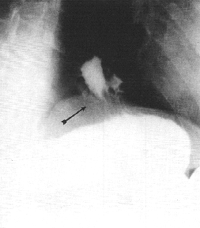 |
Fig. 32.5 A. Case N.M. Sliding hiatus hernia (arrow) |
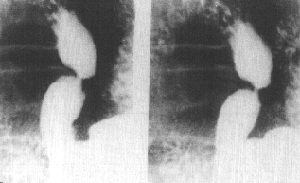 |
Fig. 32.5 B. Case N.M. Constant contraction of pyloric sphincteric cylinder |
Comment: Where there is a contracted pyloric segment in the presence of an
hiatus hernia, care should be taken to exclude a local organic lesion at the pylorus before
the diagnosis of benign contracted segment or pseudohypertrophic pyloric stenosis is
made. The following case is an example:
Case 32.6. J.L., female aged 58 years. A sliding hiatus hernia was demonstrated in
the Trendelenburg position (Fig. 32.6A). A constant, somewhat irregular
narrowing 5.0 cm in length, was present in the pyloric region, simulating contraction of
the sphincteric cylinder (Fig. 32.6B). It contained a small filling defect in its
oral side. A diagnosis of carcinoma of the pylorus was made and confirmed at
laparotomy.
A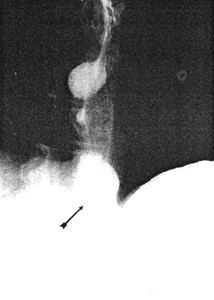 | |
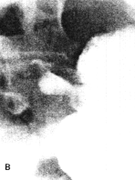  |
Fig. 32.6 A-C. Case J.L. A Sliding hiatus hernia (arrow) with reflux and oesophageal spasm and fibrosis. B,C Narrowed pyloric region with irregular walls and small filling defect. Case of pyloric carcinoma |
Previous Page | Table of Contents | Next Page
© Copyright PLiG 1998